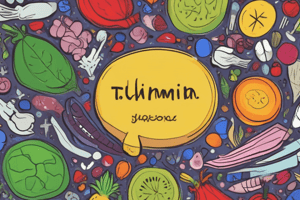Podcast
Questions and Answers
Which of the following is a key function of Vitamin B1 (thiamine)?
Which of the following is a key function of Vitamin B1 (thiamine)?
- Contributing to energy metabolism (correct)
- Enhancing vision
- Improving bone density
- Regulating blood sugar levels
Thiamine stability increases in alkaline conditions.
Thiamine stability increases in alkaline conditions.
False (B)
What dietary sources are rich in thiamine?
What dietary sources are rich in thiamine?
Whole grains, legumes, and meats
Thiamine deficiency can lead to the clinical syndrome known as __________.
Thiamine deficiency can lead to the clinical syndrome known as __________.
Match the following B-vitamins with their characteristics:
Match the following B-vitamins with their characteristics:
Which of the following factors can contribute to Vitamin B1 deficiency?
Which of the following factors can contribute to Vitamin B1 deficiency?
Riboflavin (Vitamin B2) is known to be heat-sensitive.
Riboflavin (Vitamin B2) is known to be heat-sensitive.
What role does thiamine play in the body?
What role does thiamine play in the body?
Which of the following is the richest natural source of riboflavin?
Which of the following is the richest natural source of riboflavin?
Riboflavin is unstable during cooking in the absence of light.
Riboflavin is unstable during cooking in the absence of light.
What is the role of riboflavin in the conversion of other vitamins?
What is the role of riboflavin in the conversion of other vitamins?
Which form of vitamin B6 is the most stable and commonly used as a dietary supplement?
Which form of vitamin B6 is the most stable and commonly used as a dietary supplement?
Vitamin B6 deficiency does not impact neurological function.
Vitamin B6 deficiency does not impact neurological function.
Riboflavin occurs in foods both in free form and as _____ and _____.
Riboflavin occurs in foods both in free form and as _____ and _____.
Match the food sources to their riboflavin content:
Match the food sources to their riboflavin content:
Name one source of vitamin B6.
Name one source of vitamin B6.
Vitamin B6 acts as a critical co-factor for a diverse range of biochemical reactions that regulate basic cellular __________.
Vitamin B6 acts as a critical co-factor for a diverse range of biochemical reactions that regulate basic cellular __________.
Which of the following is NOT a function of riboflavin?
Which of the following is NOT a function of riboflavin?
Free riboflavin is absorbed readily into cells of the intestinal mucosa.
Free riboflavin is absorbed readily into cells of the intestinal mucosa.
Match the following sources of vitamin B6 with their respective categories:
Match the following sources of vitamin B6 with their respective categories:
What is a primary symptom of vitamin B6 deficiency?
What is a primary symptom of vitamin B6 deficiency?
What enhances the active transport of free riboflavin?
What enhances the active transport of free riboflavin?
Riboflavin plays a role in releasing energy from _____ and _____ and _____.
Riboflavin plays a role in releasing energy from _____ and _____ and _____.
Vitamin B6 is not required for neurotransmitter synthesis.
Vitamin B6 is not required for neurotransmitter synthesis.
Which of the following statements about riboflavin is true?
Which of the following statements about riboflavin is true?
List one use of vitamin B6.
List one use of vitamin B6.
Vitamin B6 deficiency can lead to __________ lesions.
Vitamin B6 deficiency can lead to __________ lesions.
Which of the following is NOT a symptom of vitamin B6 deficiency?
Which of the following is NOT a symptom of vitamin B6 deficiency?
Which of the following foods is rich in Vitamin B7?
Which of the following foods is rich in Vitamin B7?
Vitamin B9 is also known as folate.
Vitamin B9 is also known as folate.
What important role does Vitamin B7 play in metabolism?
What important role does Vitamin B7 play in metabolism?
A deficiency in Vitamin B7 can lead to __________.
A deficiency in Vitamin B7 can lead to __________.
Match the vitamin with its primary usage:
Match the vitamin with its primary usage:
Which of these is a source of Vitamin B9?
Which of these is a source of Vitamin B9?
Vitamin B7 is not involved in protein metabolism.
Vitamin B7 is not involved in protein metabolism.
Name one vegetable that is a source of Vitamin B7.
Name one vegetable that is a source of Vitamin B7.
Sources of Vitamin B9 include __________, fresh fruits, and whole grains.
Sources of Vitamin B9 include __________, fresh fruits, and whole grains.
Match the following deficiencies with their symptoms:
Match the following deficiencies with their symptoms:
Which of the following is a crucial role of Vitamin B12 during early pregnancy?
Which of the following is a crucial role of Vitamin B12 during early pregnancy?
Vitamin B12 deficiency can lead to glossitis.
Vitamin B12 deficiency can lead to glossitis.
What is the stable form of Vitamin B12 that is frequently used in therapy?
What is the stable form of Vitamin B12 that is frequently used in therapy?
Vitamin B12 is required for the synthesis of ______ and ______.
Vitamin B12 is required for the synthesis of ______ and ______.
Match the following functions with their corresponding actions related to Vitamin B12:
Match the following functions with their corresponding actions related to Vitamin B12:
Flashcards are hidden until you start studying
Study Notes
Vitamin B1 (Thiamine)
- Thiamine is a sulfur-containing vitamin necessary for energy metabolism
- Sources include whole grains, legumes, and meats
- Alcohol inhibits thiamine absorption
- Deficiency can cause Wernicke encephalopathy, beriberi
- Risk factors include alcohol dependency, malabsorption, and a diet low in thiamine
- Thiamine is stable in an acidic environment but decomposes readily above pH 5.0
- About 50% of thiamine in foods is destroyed during cooking
Vitamin B2 (Riboflavin)
- Riboflavin is a yellow, heat-stable substance
- Sensitive to light, decomposing into lumichrome or lumiflavin depending on the solution's pH
- Neither lumichrome nor lumiflavin has physiologic activity
- Main sources include yeast, dairy products, eggs, legumes, and meats
- Also found in cereal grains, fruits, and green vegetables
- Riboflavin is stable during cooking in the absence of light
- Riboflavin occurs in foods as the free form, FMN (Flavin mononucleotide), and FAD (flavin adenine dinucleotide)
- The nucleosides are hydrolyzed to riboflavin in the upper gastrointestinal tract
- Free riboflavin is readily absorbed by an active transport system enhanced by bile salts
Vitamin B3 (Niacin)
- Niacin refers to nicotinic acid and nicotinamide
- Niacin is found in most foods, particularly those rich in protein, such as meat, poultry, fish, eggs, nuts, and seeds
- Also found in whole grains, mushrooms, avocados, and some green leafy vegetables
- Nicotinic acid is the predominant form in animal tissues
- Pyridoxamine is the most stable
Vitamin B6 (Pyridoxine)
- Vitamin B6 is essential for biological reactions including amino acid metabolism, neurotransmitter synthesis, and red blood cell formation
- Key co-factor for diverse biochemical reactions regulating basic cellular metabolism
- Sources include beef liver, tuna, salmon, fortified cereals, chickpeas, poultry, and some vegetables and fruits
- Deficiency causes peripheral neuropathy
- Symptoms of deficiency resemble those of niacin and riboflavin deficiencies, including neurological abnormalities, skin lesions, and hypochromic microcytic anemia
Vitamin B7 (Biotin)
- Biotin plays a crucial role in metabolism as a coenzyme that transfers carbon dioxide
- Essential for the breakdown of food into energy
- Involved in many cellular reactions, particularly fat and protein metabolism of hair roots, fingernails, and skin
- Found in eggs, fish, meat, seeds, nuts, and certain vegetables
- Deficiency causes fatigue, depression, and dermatitis
Vitamin B9 (Folate)
- Folate, folacin, pteroylglutamic acid, and vitamin B9 are terms referring to a material with anemia properties
- Essential for brain development and function
- Aids in the production of DNA and RNA
- Important in the metabolism of vitamins and amino acids
- Crucial during early pregnancy to reduce the risk of birth defects of the brain and spine
- Required for the synthesis of glycine, methionine, nucleotides T & U
- Sources include beans, peanuts, sunflower seeds, fresh fruits, fruit juices, whole grains, and liver
- Deficiency can cause megaloblastic and macrocytic anemias, and glossitis
Vitamin B12 (Cobalamin)
- Vitamin B12 refers to a series of porphyrin-related corrinoid derivatives that prevent pernicious anemia
- Cyanocobalamin is the most stable form and is most frequently used in therapy
- Hydroxocobalamin is also used therapeutically
- Vitamin B12 acts as a coenzyme in the conversion of homocysteine to methionine
- Plays a role in the metabolism of fatty acids and amino acids
- Involved in the production of neurotransmitters
- Maintains the lining that surrounds and protects nerve fibers
- Crucial for bone cell activity
- Plays a significant role in DNA synthesis
Studying That Suits You
Use AI to generate personalized quizzes and flashcards to suit your learning preferences.




